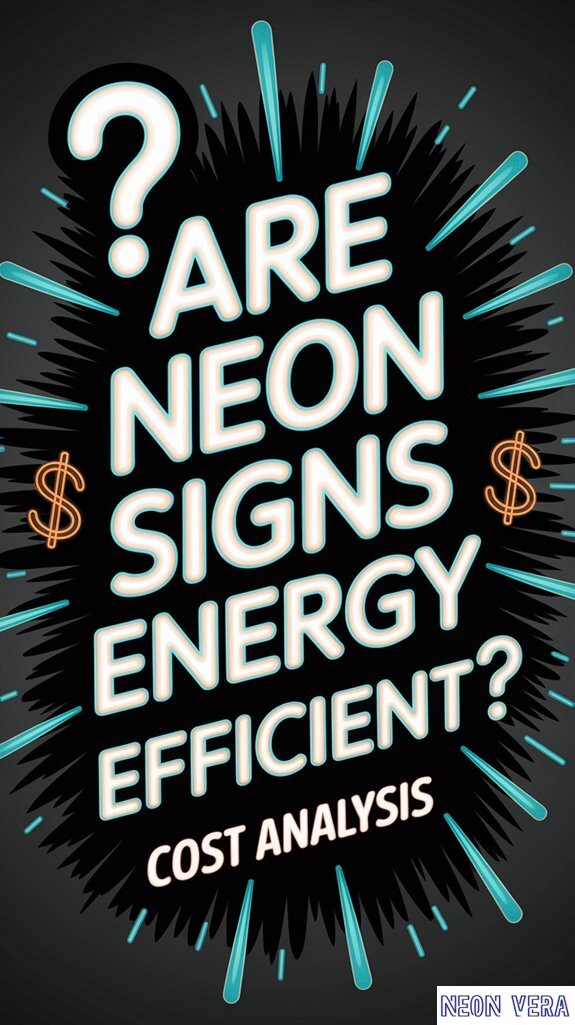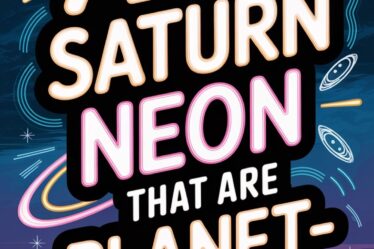
Neon signs use just 3-5 watts per foot of tubing, consuming 50-70% less electricity than LED displays at similar brightness levels. Annual electricity costs range from $100-300, while yearly maintenance runs between $50-200. Replacement components typically cost $200-500 every 8-12 years, though timers and dimming controls can improve efficiency. Strategic placement and regular maintenance help minimize both energy consumption and operating expenses.
Table of Contents
Energy Efficiency of Neon Signs
When you’re considering neon signs’ energy consumption, you’ll find they typically use between 3-5 watts per foot of tubing, making them relatively efficient compared to older illuminated signage.
You’ll notice that neon tubes generate minimal heat during operation, which contributes to their overall energy efficiency and longevity.
While power consumption varies based on size and design complexity, modern neon signs often incorporate transformers that optimize electrical usage for better performance.
Power Consumption
Although neon signs are iconic for their bright glow, they’re surprisingly energy efficient compared to many traditional lighting options.
Modern neon signs use between 3 to 5 watts per foot, proving more economical than conventional fluorescent tubes. Neon signs consume roughly 50-70% less electricity than LED displays while producing similar brightness levels.
The power requirements for neon signs vary with their dimensions, chosen colors, and design intricacy.
According to durability tests, neon signs operate continuously for 8-15 years, minimizing replacement needs. Neon’s efficient power usage and durability make it a smart investment for commercial signage.
Heat Generation
Despite their bright illumination, neon signs generate minimal heat compared to other lighting technologies. Good heat management and thermal control strategies significantly extend a sign’s operational life. Proper insulation helps optimize performance while reducing wasted energy.
| Temperature Factor | Impact | Solution |
|---|---|---|
| Ambient Heat | Affects efficiency | Strategic placement |
| Internal Heat | Influences durability | Proper ventilation |
| External Factors | Operation costs | Weather protection |
Regular temperature monitoring is crucial for long-term performance. Extreme weather conditions can impact sign function, though modern designs feature improved cooling systems. Location and environment affect thermal efficiency, requiring specific maintenance strategies.
Cost Analysis
Tracking your neon sign’s operating costs involves calculating its wattage consumption and your local electricity rates, which typically range from $0.10 to $0.30 per kilowatt-hour.
You’ll need to factor in periodic maintenance costs, including cleaning, gas refills, and potential transformer replacements every 8-10 years.
While LED alternatives may offer lower energy bills, neon signs often prove more cost-effective long-term due to their 8-15 year lifespan and minimal maintenance requirements.
Operating Costs
The operating costs of neon signs primarily stem from three key factors: electricity consumption, maintenance requirements, and replacement parts. Neon signs typically use between 3-5 watts per foot, making them more energy-efficient than traditional lighting options.
| Cost Factor | Average Annual Cost | Lifespan |
|---|---|---|
| Electricity | $100-300 | Continuous |
| Maintenance | $50-200 | As needed |
| Replacements | $200-500 | 8-12 years |
Despite higher upfront costs, neon signs prove economical long-term through reduced operating expenses, particularly with proper maintenance and efficient transformers.
Maintenance Costs
While initial purchase costs may seem steep, regular maintenance of neon signs proves surprisingly affordable compared to other illuminated signage options.
Annual routine inspections range from $75-150, helping prevent major issues and extending sign lifespan. Basic cleaning requires gentle dusting and occasional professional service, typically costing $50-100 per session.
Repairs usually involve transformer issues or tube damage. Replacement parts average $200-400, though repairs remain infrequent thanks to neon’s durability.
Well-maintained signs typically function for 8-15 years before requiring major work. Weather exposure and installation quality affect longevity more than the neon elements themselves.
Environmental Impact
When you’re considering neon signs’ environmental impact, their carbon footprint is an essential factor to examine.
Your neon sign’s energy consumption directly contributes to greenhouse gas emissions, particularly if your power source relies heavily on fossil fuels.
You’ll find that modern neon signs produce fewer carbon emissions compared to their older counterparts, thanks to improved manufacturing processes and more efficient power supplies.
Carbon Footprint
Despite their enchanting glow, neon signs contribute to environmental concerns through their carbon footprint during production and operation. Traditional neon signs produce high carbon emissions during manufacturing, especially in glass-blowing and gas-filling processes.
Reducing ecological impact is possible by selecting signs made with sustainable materials and powered by renewable energy sources.
A neon sign’s environmental impact extends beyond production to its entire operational lifespan. LED alternatives and smart controls that adjust brightness or power during off-peak hours can significantly decrease carbon emissions.
These strategies reduce environmental impact while preserving visual appeal.
Practical Applications and Recommendations
If you’re considering neon signs for your business, they’ll work best for storefronts, window displays, and indoor decorative signage where visibility and brand recognition are essential.
For residential use, you can incorporate neon signs as artistic elements in game rooms, home bars, or as accent lighting in living spaces.
Whether for business or home use, you’ll want to balance the initial investment against long-term energy costs by choosing appropriate sizes and limiting operating hours to peak visibility periods.
Business Use
Although neon signs can initially seem costly, their practical business applications make them worthwhile investments for storefronts, restaurants, and entertainment venues. When incorporating neon signs into your business strategies, you’ll find they offer unique marketing benefits and enhance customer engagement. Neon displays significantly boost brand visibility, particularly after dark when conventional signs become harder to see.
| Business Type | Sign Placement | ROI Benefits |
|---|---|---|
| Restaurants | Window Displays | 24/7 Visibility |
| Retail Stores | Storefront | Increased Foot Traffic |
| Entertainment | Rooftop/Facade | Brand Recognition |
Before installation, check your local signage regulations to guarantee compliance. Position neon signs strategically to maximize their impact while maintaining energy efficiency. Consider installing timers or dimming controls to optimize power usage during off-peak hours.
Residential Use
Neon signs’ appeal extends beyond commercial spaces into residential settings, where homeowners now embrace these vibrant displays as decorative elements.
You’ll find these glowing artworks adding personality to home bars, game rooms, and entertainment spaces. When considering neon sign placement, focus on areas that create visual impact without overwhelming your residential lighting setup.
LED neon alternatives offer energy efficiency while maintaining the classic aesthetic appeal of traditional neon.
These modern options enhance bedrooms, home offices, and living spaces with distinctive flair. Smart placement and timers help manage electricity costs while creating the perfect ambiance in your home.
Tips to Optimize Energy Efficiency
To maximize energy efficiency in your neon signs, you’ll want to establish regular maintenance practices like cleaning and inspecting transformers, wiring, and connections.
You can extend your sign’s lifespan and reduce power consumption by promptly replacing flickering or dimming tubes and ensuring all electrical components are functioning effectively.
Making operational adjustments, such as installing timers or dimming controls, will help you manage energy usage during off-peak hours while maintaining visibility.
Maintenance Practices
When properly maintained, neon signs can operate at peak energy efficiency for many years. Regular maintenance ensures optimal performance through established upkeep routines.
Start by inspecting your sign monthly for any flickering, dimming, or dead spots that might indicate electrical issues. Clean your sign every three months using a soft, damp cloth to remove dust and debris that can reduce brightness and efficiency.
Timely repairs of minor issues will extend your sign’s lifespan. Apply these longevity strategies: protect your sign from extreme weather, check transformer connections annually, and maintain proper voltage levels.
When problems arise, use these troubleshooting tips: test the power supply, examine the tube connections, and look for any physical damage. If you’re unsure about repairs, consult a professional neon technician.
Operational Adjustments
Beyond routine maintenance, simple operational adjustments can significantly reduce your neon sign’s power consumption.
Using a programmable timer aligned with business hours helps meet local lighting requirements while saving energy. Conserve power by turning off signs during daylight or after closing time.
Strategic sign placement also impacts power consumption. Position your neon sign where it’s visible but protected from direct sunlight and extreme weather, reducing the power needed to maintain brightness.
Modern neon signs offer dimming features to adjust brightness based on ambient light or time of day, saving energy while staying visible.
Conclusion
Neon signs consume more energy than many modern lighting options, but several strategies can improve their cost-effectiveness. Using LED alternatives, timers, and proper maintenance helps lower energy use and operating expenses.
When choosing neon signage, consider both upfront costs and ongoing expenses while exploring energy-efficient alternatives that deliver similar visual appeal.



